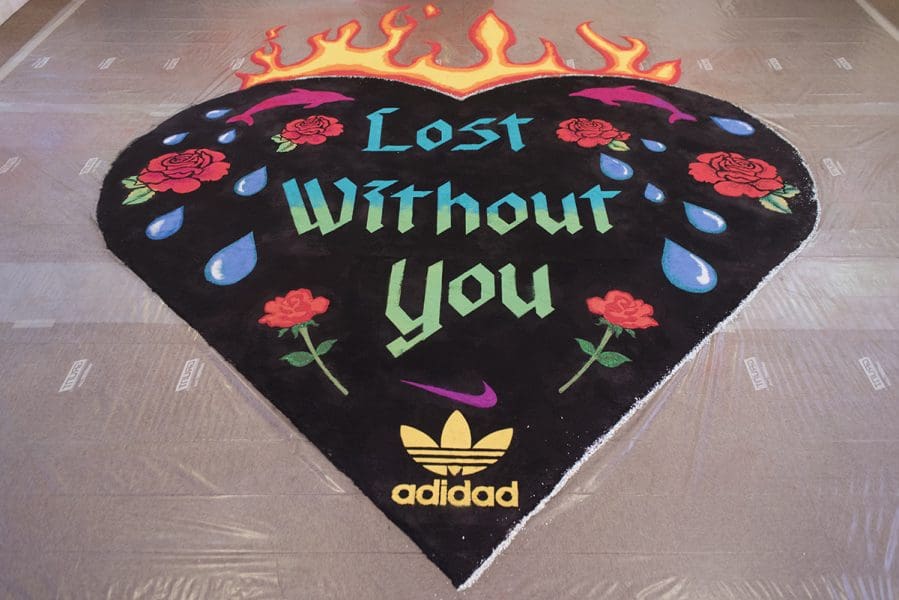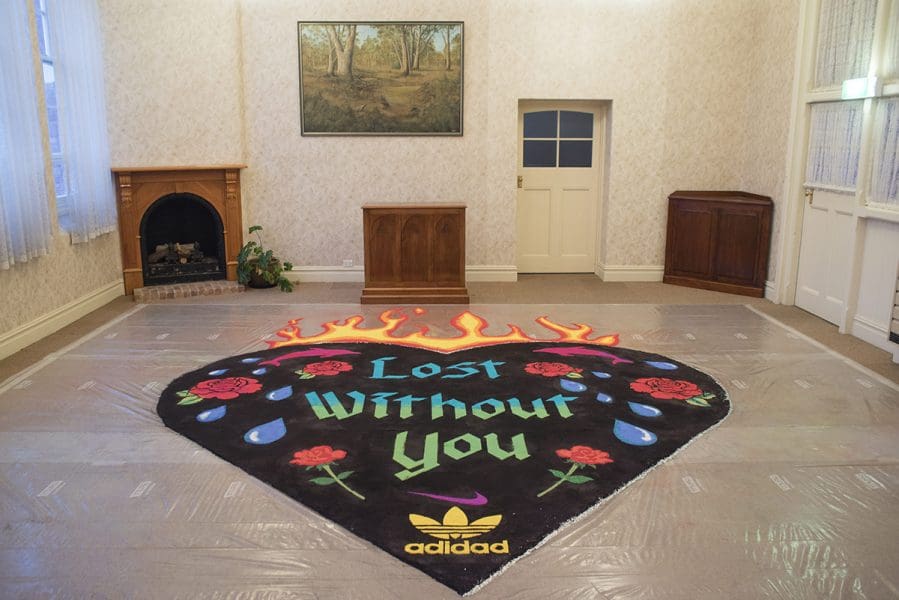
Making Space at the Table
NAP Contemporary’s group show, The Elephant Table, platforms six artists and voices—creating chaos, connection and conversation.




Interdisciplinary artist Claudia Nicholson was born in Bogota, Colombia in 1987. Adopted in infancy along with her sister, the duo were transplanted to Australia where they grew up.
Since graduating from COFA (College of Fine Arts, University of New South Wales) in 2011, her work – which both straddles and celebrates contrasting cultures, popular and ancient – has drawn in an inquisitive audience. After more than two decades of frenzied discourse around the concept of identity, Nicholson broaches the complexities with humour, resolve (there was the time she ate a raw lamb’s heart to a panpipe rendition of ‘Unchained Melody’) and freshness. Her effort has not gone unnoticed, last year she was a finalist of the Blake Prize and winner of the Fisher’s Ghost Prize at Campbelltown Arts Centre in the sculpture category.
Varia Karipoff: At what age did you recognise a yearning for, or a curiosity towards your country of birth?
Claudia Nicholson: My parents fostered in us an appreciation for Colombia from a very early age. I grew up around other children from Colombia and no one really made a big deal of it. As I got older I decided I would like to visit Colombia and I instantly fell in love with the place. I have been trying to get my head around the traditions, culture and politics ever since.
VK: Who are some of the artists or performers that you drew on from Colombia to form an understanding of your own identity?
CN: Doris Salcedo and Shakira. As a teenager Salcedo’s work was a really accessible way in which I could begin to understand and engage with the impact that the civil war has had on Colombia. The way she deals with mourning is really powerful. And Shakira was the first Colombian performer who I was really aware of.
VK: Your work documents lesser-known aspects of South American culture and contemporary sub-cultures. Tell us about the use of Adidas and Nike symbols in your work.
CN: When I was in Colombia I bought a bag that said Adidad. Since then I have used counterfeit branding as a little nod towards cultural authenticity in relation to my own practice and identity. It also references contemporary Chola* culture and the informal economies of Central and South America.
VK: Where do you see yourself on the spectrum of documenting culture, bending what is there or creating something new?
CN: Maybe I bend what is already there? I would say I conflate different aspects of Latin American culture and rearrange them to create a new narrative that talks to my own experience and hopefully the experience of other people from diasporic communities.
VK: Your work shifts across mediums – from pottery to video, to performance, to the painstaking alfombras de aserrín (sawdust carpets). Can you describe the way you approach a new work?
CN: The way I approach each work is quite different each time. Sometimes I start with research to come up with an idea, other times I work backwards from an idea. I work quite intuitively and I peruse materials that really excite me. If I’m stuck I might mine JLo lyrics for inspiration.
VK: The alfombras de aserrín (sawdust carpets used in religious festivals across Central and South America) straddle performative and aesthetic spaces. What drew you to them? How have you used them before?
CN: In Guatemala families and community groups make the alfombras for Semana Santa (Holy week). Overnight whole streets are transformed into these intricate, colourful artworks and shortly after they are finished, a religious procession comes through and walks over them. I use performance in my work to honour this durational process. I was drawn to them because of their obvious beauty and their ephemeral nature. I think that is what makes them so captivating. For the C3West project Women of Fairfield I installed one in a really beautiful food court in Fairfield. I collaborated with women from the local Latina community who were involved in various performance groups to design and perform in the work.
VK: Can you tell us about the work you are exhibiting at Carriageworks during The National?
CN: All I have are dreams of you is a project based on the late Tejano singer Selena Quintanilla. I’m interested in Selena because of the way she straddled Mexican and American cultures. At a time when people in the Hispanic community were underrepresented in mainstream American culture she was someone who spoke directly to a second and third generation of Mexican migrants. Selena carved out a space for young people with multiple cultural identities. Following her death the collective grief was immense. I think it is relevant to remember her in 2017 and within an Australian context because of the nature of rhetoric around immigration in our current political climate. Selena is an example of the way popular culture can be a powerful tool to dismantle racial prejudices.
VK: What does it entail?
CN: I will be making a large alfombras de aserrín at Carriageworks dedicated to Selena. The work will act as a site of collective remembrance. Local performers, predominantly from Sydney’s Latin American community will perform her songs at a mini tribute concert at the beginning and end of the exhibition.
VK: How do you reconcile the differences between Australian and South American culture in your work?
CN: I am not sure if I do reconcile the differences. Maybe I celebrate them? Or more I investigate them from an awkward outsider/insider position.
VK: What is something that you saw or read recently that has had an impact on your practice?
CN: “Outrage about violence becomes the cause of a disturbance and not the violence itself” – Sara Ahmed. This quote was in Some walls fall/out by Spence Messih. The whole publication was put together so beautifully. Also Moonlight and Frank Ocean’s video for Nike really moved me.
VK: What are you looking forward to?
CN: Anastasia Zaravinos, Emily O’Connor and Spence Messih are collaborating on a work. I am really looking forward to seeing that. I am also looking forward to going on a beach holiday to Currarong. Nothing is planned yet but if I put it out there maybe it will happen.
* Initially used by European colonisers to describe Indigenous people of Central and South America, whether full or ‘mixed’, the term was reclaimed by Mexican Americans starting in the 1960s.